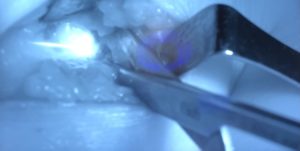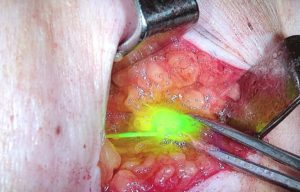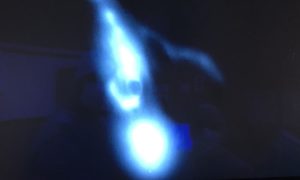
Fluorescence, l’innovation pour le cancer du sein

Illustration : Chirurgie d’un cancer du sein , Dr ESTINGOY Frédéric
Détection d’un ganglion sentinelle fluorescent au Bloc opératoire de la clinique des cèdres




. 2020 Oct 22. doi: 10.1111/tbj.14100. Online ahead of print.
Indocyanine green for sentinel lymph node detection in early breast cancer: Prospective evaluation of detection rate and toxicity-The FLUOBREAST trial
Charlotte Ngô 1, Shervine Sharifzadehgan 2, Cynthia Lecurieux-Lafayette 2, Houda Belhouari 3, Dominique Rousseau 4, Hélène Bonsang-Kitzis 1, Laurence Crouillebois 3, Vincent Balaya 5, Stéphane Oudard 3 6 7, Fabrice Lécuru 6 8, Reza-Thierry Elaidi 3
PMID: 33094498 DOI: 10.1111/tbj.14100
Abstract
Introduction: Detection of sentinel lymph node in early breast cancer is commonly based on the combination of patent blue dye and a radioisotope 99m Technetium. Each of these two tracers has advantages and disadvantages leading to the development of the use of indocyanine green.
Methods: We conducted a prospective clinical trial to compare the detection rate of indocyanine green with 99mTe. Each patient undergoing a sentinel lymph node biopsy for an early breast cancer received both indocyanine green and radioisotopes. The trial was registered: FLUOBREAST EudraCT N 2015-000698-11, ClinicalTrials.gov: NCT02875626.
Results: Among a total of 88 patients, 77 were assessable for a total of 205 nodes. Detection rates were 93% for the isotope and 96% for the indocyanine green. The combined detection rate was 99%. The overall concordance rate per patient was 91%. The median number of excised sentinel nodes was 2.3 for each tracer and 2.7 for the combined method (P = .21). All the macrometastatic nodes were detected by both indocyanine green and radioisotopes. The median time between incision of the axilla and removal of the last node was 14 minutes. There was neither allergy nor radio-sensitization linked with the use of indocyanine green.
Conclusions: Indocyanine green delivers a high detection rate and sensitivity for the sentinel lymph node biopsy in early breast cancer, with short operative time and a normal number of excised sentinel lymph nodes. Allergy is extremely rare and there is no toxicity. Indocyanine green could be an alternative to radioisotopes to provide an accurate staging of the axilla. Its routine use should be approved.
Keywords: axillary staging; breast cancer; indocyanine green; sentinel lymph node.